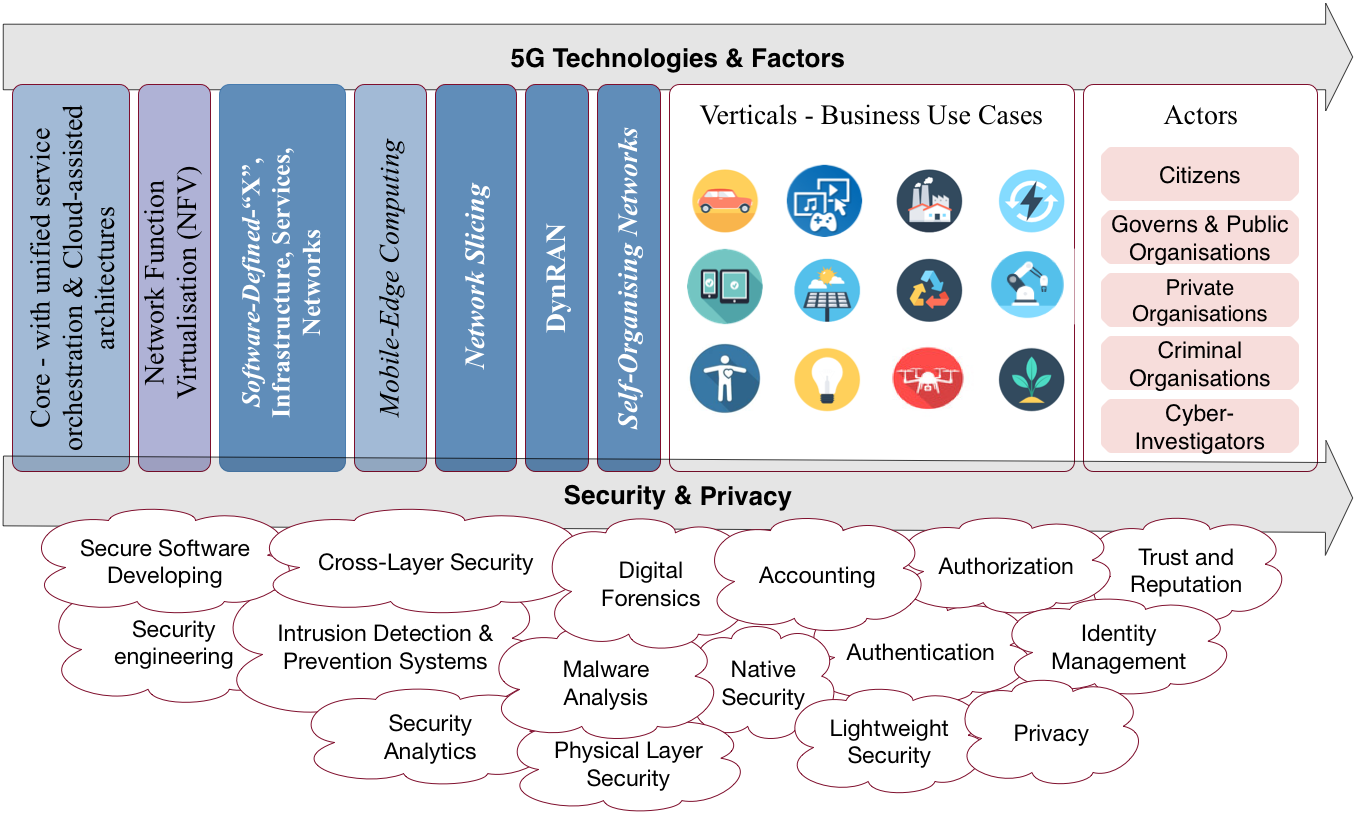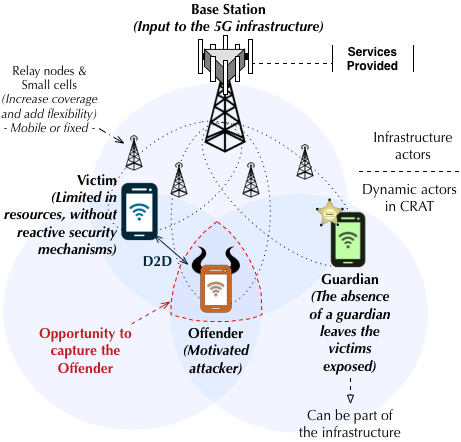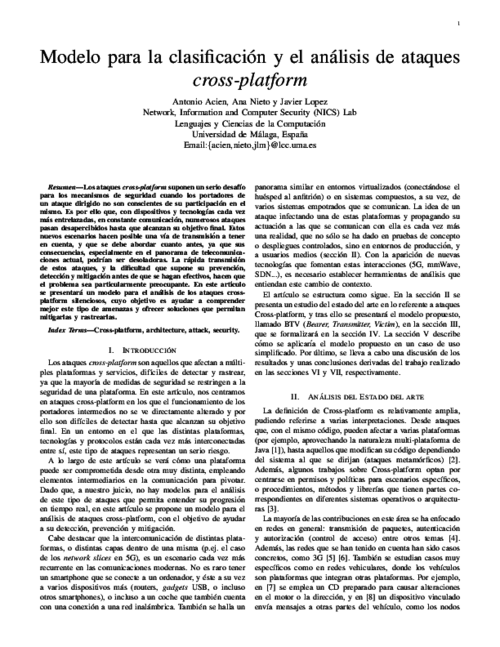5G Security
Unlike previous generations, the fifth generation of cellular networks (5G) is based on the success of revolutionary technologies and factors that define a new and challenging ecosystem, closest to the end-user more than ever before. Some of the key technologies or enablers to 5G are shown in the following figure. In NICS lab we firmly believe that security should be considered for each technology, but also in a general way, understanding the impact that the different technological levels have on each other and the possible dependencies arising from cooperation.

It sould be highlighted the impact of software-defined networks, infrastructures and services in the definition of 5G use cases. Indeed, the communication infrastructure is migrating to software-based architectures, more flexible than the previous ones, but also more complicated for orchestrating and managing distributed services. In this new technological ecosystem it will be fundamental to promote proactive security solutions that adapt to the context with great flexibility. Precisely, this is one of the main objectives pursued in the work we do in NICS lab. This goes far beyond providing real-time security solutions; it means that the 5G infrastructure will be prepared to be proactive by design. This requires defining the security requirements and deploying the basic enablers (e.g. specific software and hardware devices for security tasks) before deploying other security solutions. Thus, an important part of our research is to model different 5G scenarios in realistic simulations which make it possible for us to analyse the potential problems and offer solutions to them.
The following sections describe the main research lines in 5G carried out in NICS Lab.
Analysing cross-layer attacks
5G will rely on technologies that provide endlessnew technological opportunities; Networks do not longer rely onspecific hardware necessarily, as they can be software-defined, and a lot of their functions can be virtualized. This, whileintroducing greater flexibility, also exposes the network to greatersecurity risks. Therefore, the risk of a attack breaking intoa virtualized environment, or the presence of exploits in thesoftware used to define networks can bring down a wholeinfrastructure, and both can be targeted from devices whichare in acompletely different platform. Cross-layer attacks are particularly worrying, since they are difficult to categorise, identify and prevent. This, paired with the availability of devicesthat have more connectivity and new technologies that allow the expansion of attacks quite easily make it a very concerning scenario.

As a particular use case of this type of attacks, cross-platform attacks are analysed in [1], where the architecture BTV (bearer, transmitter and victim) is formalized for the analysis of this type of attacks. Cross-platform attacks are not new, but their effect on 5G networks can be much more devastating if intermediate architectures are not ready to recognize them. An important challenge lies in including inter-layer detectors capable of detecting attacks of this nature.
Proactive Digital Forensics in 5G-IoT
Proactive digital forensics is a relatively new term that has not yet been applied to 5G environments. Unlike traditional digital forensics, proactive approaches are more dynamic, enabling the system to collect digital evidence periodically, without stopping the functioning of the IT infrastructure (in optimal cases). Although not all systems support this type of action, proactive digital forensic solutions for 5G would allow them to slow down attacks if these are combined with known network security elements (e.g. IDS, SIEMs).

A formalisation of these issues in 5G environments is provided in [2]. The analysis extracts the requirements that should be considered considering four layers: end-user, application, control and infrastructure, following the natural architecture of a software-defined environment. In addition to showing the requirements per layer, it is sought to break down the inter-layer requirements to facilitate the identification of common requirements. In general, the analysis carried out is aimed at finding ways to facilitate orchestration and cooperation between services at different levels. Indeed, the need to seek cooperation mechanisms for 5G-IoT environments is argued in [3]. In this case, different forms of crowdsourcing applicable to the 5G-ToT ecosystem are analysed, and a proof of concept considering the Digital Witness solution is shown. Precisely, one of the priority actions in this line is the implementation of a prototype that demonstrates the possible acquisition and management of electronic evidence satisfying digital forensic requirements in 5G-IoT ecosystems, following the IoT-Forensic approach impulsed by the IoTest project. A first proof of concept of this approach has been successfully implemented using the open-source simulator OMNET++. The results, published in [4], show the advantages of employing devices that act as guardians of the communications infrastructure.
These guardians can be either, software or physical, but they must cooperate to improve detection and recovery from attacks. In particular, this work focuses on attacks based on proximity that mainly affect the last layers, closer to the user. However, they would be extensible to other levels.
Security and QoS trade-offs in 5G
The growing number of parameters in heterogeneous networks, as is the case of the fifth generation (5G) Green networks, greatly complicates the analysis of the Security and Quality of Service Tradeoff (SQT). However, studying these types of relationships is crucial in Future Internet scenarios to prevent potential points of failure and to enhance the use of limited resources, increasing the user’s experience. Therefore, it is fundamental to provide tools and models for training, so that the users understand these dependencies and solve them prior to deploying new solutions.
In a 5G Green relay environment, the nodes can cooperate to send information to the destination, generating large amounts of data, from which information about the user’s preferences, network performance, and QoS can be inferred. This information can be useful to identify the effect that different technologies and configurations have on security and QoS.
These dependencies at different layers at a given moment can be understood as the context of a system. As 5G Green relay networks can involve from low-complexity personal devices to more powerful devices, assessing the security and QoS tradeoff is highly complex; it depends on the mechanisms to be deployed in a heterogeneous, dynamic and unpredictable environment. However, the final configuration of the environment cannot be independent from the analysis of the security and QoS tradeoff.
The Security and QoS Tradeoff Recommendation System (SQT-RS) presented in [5] is a first step in this direction. The specification can be used in 5G Green parametric-based systems to provide recommendations based on different goals, and contexts are generated dynamically, based on the user’s input. SQT-RS has been implemented to provide recommendations in Context-based Parametric Relationship Model (CPRM) compliant scenarios with large numbers of parameters [6], based on the requirements of various types of relays in 5G networks [7].
References
-
"Modelo para la clasificación y análisis de ataques Cross-Platform",
IV Jornadas Nacionales de Investigación en Ciberseguridad (JNIC 2018), Servicio Editorial de Mondragon Unibertsitatea, 06/2018.
 More..
More..Abstract
Los ataques cross-platform suponen un serio desafío para los mecanismos de seguridad cuando los portadores de un ataque dirigido no son conscientes de su participacion en el mismo. Es por ello que, con dispositivos y tecnologías cada vez mas entrelazadas, en constante comunicación, numerosos ataques pasan desapercibidos hasta que alcanzan su objetivo final. Estos nuevos escenarios hacen posible una vía de transmision a tener en cuenta, y que se debe abordar cuanto antes, ya que sus consecuencias, especialmente en el panorama de telecomunicaciones actual, podrían ser desoladoras. La rapida transmisión de estos ataques, y la dificultad que supone su prevencion, detección y mitigación antes de que se hagan efectivos, hacen que el problema sea particularmente preocupante. En este artículo se presentará una arquitectura para el analisis de los ataques cross-platform silenciosos, cuyo objetivo es ayudar a comprender mejor este tipo de amenazas y ofrecer soluciones que permitan mitigarlas y rastrearlas.

- Citekey 1697 not found
-
"Crowdsourcing analysis in 5G IoT: Cybersecurity Threats and Mitigation",
Mobile Networks and Applications (MONET), Springer US, pp. 881-889, 10/2018. DOI
 (I.F.: 2.39)More..
(I.F.: 2.39)More..Abstract
Crowdsourcing can be a powerful weapon against cyberattacks in 5G networks. In this paper we analyse this idea in detail, starting from the use cases in crowdsourcing focused on security, and highlighting those areas of a 5G ecosystem where crowdsourcing could be used to mitigate local and remote attacks, as well as to discourage criminal activities and cybercriminal behaviour. We pay particular attention to the capillary network, where an infinite number of IoT objects coexist. The analysis is made considering the different participants in a 5G IoT ecosystem.
Impact Factor: 2.39Journal Citation Reports® Science Edition (Thomson Reuters, 2018)
-
"Capture the RAT: Proximity-based Attacks in 5G using the Routine Activity Theory",
The 16th IEEE International Conference on Dependable, Autonomic and Secure Computing (DASC 2018), IEEE, pp. 520-527, 08/2018. DOI
 More..
More..Abstract
The fifth generation of cellular networks (5G) will enable different use cases where security will be more critical than ever before (e.g. autonomous vehicles and critical IoT devices). Unfortunately, the new networks are being built on the certainty that security problems can not be solved in the short term. Far from reinventing the wheel, one of our goals is to allow security software developers to implement and test their reactive solutions for the capillary network of 5G devices. Therefore, in this paper a solution for analysing proximity-based attacks in 5G environments is modelled and tested using OMNET++. The solution, named CRAT, is able to decouple the security analysis from the hardware of the device with the aim to extend the analysis of proximity-based attacks to different use-cases in 5G. We follow a high-level approach, in which the devices can take the role of victim, offender and guardian following the principles of the routine activity theory.

-
"Dynamic Knowledge-based Analysis in non-Secure 5G Green Environments using Contextual Data",
IEEE Systems Journal, vol. 11, issue 4, no. 99, IEEE, pp. 2479-2489, 12/2017. DOI
 (I.F.: 4.337)More..
(I.F.: 4.337)More..Abstract
The growing number of parameters in heteroge- neous networks, as is the case of the fifth generation (5G) Green networks, greatly complicates the analysis of the Security and Quality of Service Tradeoff (SQT). However, studying these types of relationships is crucial in Future Internet scenarios to prevent potential points of failure and to enhance the use of limited resources, increasing the user’s experience. Therefore, it is fundamental to provide tools and models for training, so that the users understand these dependencies and solve them prior to deploying new solutions. In this paper, a Recommendation System for SQT (SQT-RS) is deployed in 5G Green systems, considering the particular case of relay networks and the impact of eavesdropping and jamming contexts on the models generated by the user, aided by SQT-RS. With this goal in mind, we provide a component for the user to automatically select specific contexts based on 5G Green capabilities.
Impact Factor: 4.337Journal Citation Reports® Science Edition (Thomson Reuters, 2017)
-
"A Context-based Parametric Relationship Model (CPRM) to Measure the Security and QoS tradeoff in Configurable Environments",
IEEE International Conference on Communications (ICC'14), IEEE Communications Society, pp. 755-760, 06/2014. DOI

 More..
More..Abstract
Heterogeneity of future networks requires the use of extensible models to understand the Security and QoS tradeoff. We believe that a good starting point is to analyze the Security and QoS tradeoff from a parametric point of view and, for this reason, in a previous paper, we defined the Parametric Rela- tionship Model (PRM) to define relationships between Security and QoS parameters. In this paper, we extend that approach in order to change the behaviour of the model so that different contexts in the same system are considered; that is, to provide a Context-based Parametric Relationship Model (CPRM). The final aim is to provide useful tools for system administrators in order to help them deal with Security and QoS tradeoff issues in the configuration of the environment.

-
"Relay Selection for Secure 5G Green Communications",
Telecommunication Systems , vol. 59, issue 1, Springer US, pp. 169-187, 05/2015. DOI (I.F.: 0.822)More..
(I.F.: 0.822)More..Abstract
In this article, we present relay selection policies in applications with secrecy requirements which are of interest in the fifth generation (5G) of wireless networks. More specifically, we provide a classification of relays based on their distinct communication attributes, such as processing, multiple antennas, storage, channel estimation, density and security level. In addition, we discuss the level of efficiency exhibited by each relay class, regarding their impact in delay-critical applications and green communications applications, while aiming at a specific security level at the physical layer. Then, relay selection policies are proposed taking into consideration the goals set by each application. Numerical evaluation of the proposed policies in terms of the average secrecy rate, average delay and power reduction show improved performance compared to other state-of-the-art solutions.
Impact Factor: 0.822Journal Citation Reports® Science Edition (Thomson Reuters, 2015)